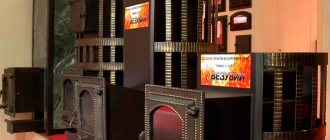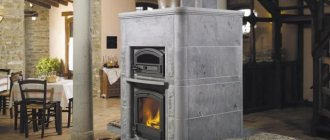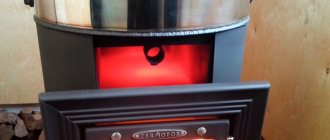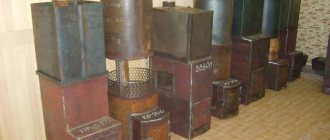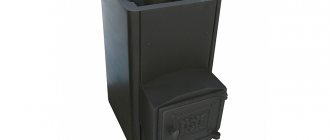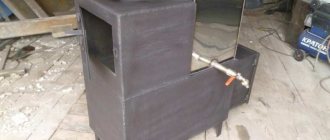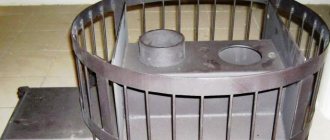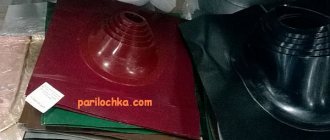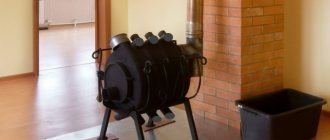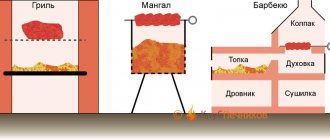Domestic manufacturers are occupying an increasingly strong position in the market for bath stoves. Their products do not always have an attractive design, but the quality of the units and their properties are often at their best. One of these. This company began producing bath stoves 10 years ago, having previously studied the experience of leading and domestic manufacturers. As a result, “Varvara” bath stoves are in stable demand and have almost no complaints about quality.
Furnace structure using the example of the Varvara Classic model
How to properly brick Varvara
Bathhouse attendants often jokingly call the “Barbara” design “as simple as a rake.”
After all, in essence, this is a good metal potbelly stove with a mesh for stones. But surprisingly, it is quite durable and effective in use. To create the climate of a real Russian bathhouse, “Varvara” needs to be covered with bricks. But that’s right. Here, for example, is one of the proven ways to make a strong and inexpensive foundation for “Varvara” in a bathhouse from logs, and properly cover it:
Step 1. There is no need to remove the timber and disturb the piping - only one side of the foundation should be placed under the wall. So that the stove screen goes into the rest room. It also needs to be covered with waterproofing and cutting of the wall should begin from the second crown. It all looks like this: the foundation is placed under the wall, the lower crown remains untouched and the screen is laid directly through the insulation. The masonry itself is tied with the rest of the stove lining in the steam room. This will make the structure especially strong.
Step 2. Now heat the oven well outside so that there is no longer an unpleasant smell and the paint is polymerized. We place the first row on the mortar - with an accurate horizontal check at the building level. Next, lay out the dry brick. The stove itself must ultimately be placed on two layers of bricks and one galvanized sheet.
Step 3. Next, the lining of the furnace itself begins: fireclay bricks will be good for the firebox, as in places in contact with fire and high temperatures, for the rest of the masonry - hollow facing bricks. The cavities need to be filled with sand - this can be done when the furnace is actually being lined and not being built
And finally, it is important to provide thermal gaps for bricks in advance. Step 4. The solution for laying the screen must be mixed based on fireclay clay
The mortar for laying the screen must be mixed using fireclay clay.
Step 4. The solution for laying the screen must be mixed based on fireclay clay
You can buy it at a regular hardware store - in 20-kilogram plastic bags, and simply dilute it with water. Even brick ovens are used with it, because it can withstand temperatures up to 1500˚C and well compensates for the expansion of masonry. You can also use basalt cardboard - it is very light, but at the same time it can withstand high temperatures in the firebox area.
Step 5. We line the pipe with half a brick, leaving two channels at the base. When lining the back of the furnace, one brick may not be placed - in order to create a convective flow. And an ordinary plastic sewer pipe makes a good exhaust hood.
Step 6. Cut out a sheet from the metal screen that will cover the heater. We put two small doors at the bottom of the lining and another large one on the sides of the oven - they will create an air flow. By the way, it will be possible to switch between the doors themselves the inflow under the stove in the “from the rest room” and “from the washing room” modes.
Here are detailed instructions on how to install a good quality stove in a bathhouse for relatively little money.
FAQ
Is there a cleanout hole in the stove?
Yes. On the chimney side there is a bolted plate.
When the stove was lit and the door was opened, smoke began to come out. After 15 minutes of burning, I decided to open the door again and smoke came out again. During the second kindling, when the firewood was fully loaded, the smoke seemed to decrease. How to prevent smoke from escaping when the door is open?
To prevent smoke from escaping, close the vent completely before opening the firebox door. In some models, on the contrary, you need to open the blower completely. Check it out on yours. You cannot completely fill the firebox with wood. They should be laid at the rate of 1/3 of the firebox (maximum 2/3).
How long will the stove burn? Yesterday I drowned mine for the second time, there is still a strong smell.
To burn out the smell of paint, the stove needs to be heated 2-3 times, preferably in the open air or with the doors and windows completely open.
The range of these sauna stoves
As he himself states, they began to produce baths after a thorough analysis of the pros and cons of domestic models - and therefore all the pros and cons of competitors are taken into account.
Any “Barbara” model creates a comfortable temperature and good steam in the bathhouse. There are three main serial “Barbarians”:
An oven with a heating circuit and a tank, which is located at the top and has a capacity of 120 liters.
These stoves are intended for those baths where there is a water supply or a pumping station with water supplied to it. Here the tank is essentially a passage through the ceiling. The steam from such a stove is discharged to the street through a steam outlet. And the heating circuit itself is made of stainless steel 1.5 mm thick, where hot water circulates. Such a stove can even handle a steam room up to 30 m3. By the way, if such a large tank is not needed, it can be replaced with a standard 60 liter one.
Stove with a side-mounted tank - 50 liters.
This model is ideal for baths where it is not possible to connect or organize water supply. But such a stove can be installed record-breakingly quickly and easily, is easy to maintain and serves for a long time and without problems due to its simplicity.
A stove without a tank - with and without a circuit.
Main advantages
When choosing a stove from the “Varvara” series for their bathhouse, the average consumer pays attention to a number of its distinctive features, which favorably emphasize the correctness of the choice . These include:
- Simplicity and reliability of execution.
- Favorable location in the price space.
- Ease of installation.
- The weight of the complex allows the installation of a furnace without installing a reinforced foundation.
- Good case design.
- Overall dimensions that make it possible to successfully fit the design into any interior.
- The vapor removal pipe located on the tank makes the air in the steam room similar to the air in a good sauna with a brick oven.
Illustrative examples in the interior
Heating structures from the Varvara brand can be used in any stylistic image. Let's look at some variations that are most popular at the moment.
Classic style
The interior of a bathhouse in a classic style involves the use of natural wood. Regardless of the size of the room, the design is characterized by basic elements.
- Current accessories: handmade bast shoes on the walls, amulets, a wooden bucket with a ladle, runners on the benches. The effect of antiquity is created precisely due to such elements.
- Shelves, which are made from solid wood, can be of different designs.
- A heater stove is the main attribute of a Russian bath. It is mainly made of brick, and the cladding is made using natural stone. The best option is to buy a ready-made stove made of steel and have the lining made of stone.
- Lighting. To create a warm atmosphere in the room, it is better to use spotlights or sconces with lampshades.
- Furniture set. In this case, massive wooden tables with benches are used.
- Fragrances. A real Russian bathhouse is characterized not only by its wooden structure, but also by its specific smells. To relax and calm the body, use aromatic oils from lavender, eucalyptus, and the aroma of steamed birch broom will have a calming effect on a person.
Modern style
Modern baths have large room sizes. Additionally, there are relaxation rooms, a shower room, a swimming pool, and a veranda. The lounge room is equipped with additional furniture (plasma TV, armchairs, sofa, table). The outdated brick stove is being replaced with a portable metal structure.
The walls of the steam room are lined with wooden clapboards, which must be located in a vertical position. Thanks to this, there is less accumulation of condensation in the cracks. The floor in a modern bathhouse can be not only wooden, but also tiled. The modern look suggests installing lighting fixtures anywhere, even at the edges of shelves.
To learn why you need to choose a stove for a “Varvara” bathhouse, see the following video.
Dimensions
The “Varvara” and “Mini Varvara” stoves are available in 2 variations, which have different doors in the combustion chamber:
- cast iron door;
- door made of steel (4 mm) with heat-resistant glass.
Door window parameters:
- “Varvara” – 290 mm x 310 mm;
- “Mini Varvara” – 220 mm x 260 mm.
It happens that the size of the room does not allow installing the device so that the oven door is located in the next room. To alleviate this problem, there are models “Kamenka”, “Skazka”, “Woodpile” with 3 parameters for the removal of the fuel structure:
- short combustion chamber – 4 cm;
- standardized firebox – 16 cm;
- elongated fire chamber – 30 cm.
Varieties of mini-ovens have the following combustion chamber dimensions:
- short firebox – 2 cm;
- standardized combustion chamber – 14 cm;
- elongated fire chamber – 28 cm.
Varvara with brickwork
Building a brick stove for a bathhouse is labor-intensive work, but it is worth it. The main thing is choosing quality material and following the instructions.
Tips for using the oven:
- Chopped and dry firewood is suitable for the stove. Wet logs take up energy to evaporate moisture, which means more fuel is wasted.
- Light wood in the stove only when the chimney is fully open and the ash pan is 5 cm wide.
- Clean the inside of the oven and water tank once a month.
- If the stove becomes red hot when adding wood, stop adding logs and pull out the extra ones. Open the stove chimney halfway.
- To heat water instantly, throw hot stones into it. Use metal tongs.
Using these recommendations, you can safely light a sauna.
Be first!
The advantages of this improved design will be:
- increased thermal capacity of the structure. The brick will accumulate the energy received and release it gradually as it cools;
- a special design that differs from analogues (especially if natural stone is used instead of brickwork);
- along with the appearance, another filling of the space with dry heat appears, characteristic only of the steam rooms of Russian baths.
The main disadvantage of this installation method is the large mass of bricks, which, superimposed on the weight of the stove, leads to the need to install a new stove foundation.
The second problem is finding a qualified stove master who will make high-quality masonry based on a composition suitable for high temperatures from a mixture of clay (preferably fireclay) and sand.
The reason for the wide popularity of the manufactured bath heating units was a detailed acquaintance with all the problems that arose during the operation of similar systems in the past. A detailed study of the demand for stoves and the possible market for their sales has led to a high level of use of their products by the population.
The resulting model range has many positive qualities that the consumer needs, and possible disadvantages are minimized.
The main disadvantage is the large weight of the brick combined with the weight of the stove itself
Models of stoves with brickwork have an attractive appearance. Advantages of the units:
- Increased heat capacity of equipment. Bricks accumulate the heat they receive and gradually release it as they cool.
- The space in which such equipment is installed is filled with dry heat; such characteristics are characteristic of steam rooms only in Russian baths.
- A design that differs from analogues, especially if decorative stone is used instead of ordinary brick.
Instructions
To create the climate of a real Russian bath, the Varvara stove is lined with brick.
Here is the most economical variation of the foundation for the Varvara stove made of logs and proper cladding:
- Only one side of the foundation is brought under the wall so that the stove screen extends into the recreation room. It must be covered with waterproofing material, and cutting the wall begins with 2 crowns. As a result, the foundation will be as close as possible to the wall. The brick screen is combined with the other side of the oven, which is located in the steam room.
- Before you begin installing the stove, you need to heat it outside. This is necessary in order to get rid of the unpleasant factory smell. The first row of bricks is laid on the mortar in accordance with the building level.
- Fire bricks are used in the area near the combustion chamber. In other areas, the use of facing bricks is permitted. Its sinuses are filled with ordinary sand.
- The brick screen is made from fire-resistant clay mass. It can withstand temperatures up to 1500 degrees. You can purchase it at any hardware store.
- A piece suitable for the screen is cut out of a metal sheet, which can later be used to cover the area of the heater.
Creating a brick screen has its advantages:
- accumulates the received heat, and will release energy gradually as it cools;
- appearance – for a modern style you can use natural stone;
- dry heat appears in the brickwork, which is characteristic only of Russian steam rooms.
General characteristics and design features
“Varvara” bathhouse stoves are characterized by their simplicity of design. This is one of the main qualities for which users love it.
All sauna stoves include the following components:
- a heating casing that transfers its own heat to the room;
- firebox for burning wood - heat is transferred from here to the main structure;
- chimney;
- the furnace chamber is located next to the firebox - this is where the final decay of the generated flue gases occurs;
- grate and ash pit.
Furnace structure using the example of the Varvara Classic model
There are 8 models of sauna stoves available. Despite this limited choice, the thoughtful design meets all buyer requirements:
- a stove equipped with a water tank mounted on its side;
- standard equipment, not equipped with a heat exchanger and tank;
- modification of a previous furnace with a water heating circuit.
Another feature of the product is the ability to use the stove as a boiler as part of a water heating system. In most cases, the side tank has a capacity of up to 60 liters.
The operation of such ovens is simple. Having laid the firewood, place some thin wood chips near the door for kindling. Now open the slide valve completely and open the ash pan slightly and light the wood. The firebox door must always be kept closed. After the firewood has ignited, the ash pan drawer is completely closed and the air damper is closed.
All that remains is to wait for the steam room to warm up and enjoy the fragrant steam. Do not use damp firewood; the humidity level is at least 20-30%.
You should not burn resinous fuel; in this case, the chimney will have to be cleaned more often than once a month. At the first symptoms of deterioration in draft, immediately repair the breakdown or clean the ventilation pipes.
There are currently 8 models of sauna stoves available.
A well-thought-out design allows us to limit ourselves to the production of a small number of models that can be configured to meet the specific requirements of the buyer:
- Standard oven without tank and heat exchanger.
- Modification of the same furnace with a water heating circuit.
- A stove with a water tank mounted on its side.
The built-in water heating circuit allows you to equip the stove with a capacity of up to 120 liters. Most often, it is installed at the top, acting as a matching element, between the hot pipe and the ceiling. The user receives a double benefit - the pipe heats the liquid in the tank, which eliminates the need to use protective materials to isolate the pipe from the floor and ceiling materials.
The second feature of this model is the possibility of using the stove as a boiler as part of a water heating system using batteries (registers). The use of liquid heating or the presence of a tank with large dimensions is a consequence of the use of an external water supply for filling them.
All of the listed stove options are designed for a steam room volume of up to 24 cubic meters. meters. There are smaller versions - “Varvara-mini”, which, having its own weight of 82 kg, can heat a steam room up to 12 cubic meters. meters. These babies are designed for a spacious heater and are complemented by a side tank of 39 liters.
, which is located in Tver, began producing its stove products about 10 years ago, and this brand is still in great demand and has positive reviews from the owners.
Thanks to the complete designs, they can be installed in the smallest steam rooms. Various models of stoves allow you to create a unique image in the bathhouse.
have earned demand precisely because high-quality building materials are used to make the structure. And also manufacturers are based on the wishes of customers. All products are tested for compliance with European quality.
There is only one type of fuel used - firewood. The steam room warms up time is 1-1.5 hours. After the firewood has completely burned out, the room cools down quite quickly. But the manufacturer has produced models with two stoves that retain heat in the room much longer. This occurs due to the cladding of the structure with natural stones.
Model Terma-Skazka
There are currently 8 models of sauna stoves available. The most popular medium-sized stove is the Terma-Skazka stove with a closed heater. A distinctive feature of this model is that the stove heater is lined with soapstone stone. This allows you to obtain soft steam by heating the stone to higher temperatures. Main characteristics:
- Height x Width x Length - 1120 x 500 x 800
- Weight - 245 kg
- Steam room volume - 12-24 cubic meters
- How many stones can you put - 60-70 kg
- Firebox length - 76cm
- What to heat with - wood
- Manufacturer's recommended price - 49,500 rubles
The lineup
Models “Classic” and “Polenitsa”
The stoves have similar characteristics:
- Weight 90-120 kg;
- The maximum volume of the steam room is 24 m 3 ;
- Weight of stones – 50 kg;
- Fuel - firewood;
- Air heating from 20 o C to 100 o C in 60 minutes.
Drawing of the Varvara Classic stove.
Both can be equipped with a remote tank, which is connected to the existing water supply system (it is possible to fill the tank if there is a pump). This modification allows you to organize a shower - you will need to install a mixer. These models are also available with a water heating circuit made of 1.5 mm thick stainless steel. In this case, the stove can be connected to the heating system and used to heat rooms.
Models without water heater circuits are rational to use if water is heated in boilers. It is also possible to equip the stove with a hanging tank.
"Varvara Classic" with a hanging water tank
It is convenient to use a hanging tank in cases where water is not supplied to the bathhouse. The hinged tank can always be removed and washed, because it is no secret that plaque will form on the inner surface of the tank.
“Varvara Palenitsa” has slightly smaller dimensions than “Varvara Classic”.
Drawing of the Varvara Palenica stove
Externally, “Varvara Palenica” differs little from “Varvara Classic”.
Heater models
The two Varvara Kamenka models differ in the location and weight of stones and dimensions.
- Dimensions (HxWxD): 780x560x780 mm
- Weight: no more than 90-120 kg.
- Weight of laid stones: not less than 180 kg.
- Maximum volume of steam room: 24 m 3
- Heating time of the steam room from 20 0C to 100 0C (provided proper thermal insulation): 60 minutes.
- Combustion chamber offset: 140 mm
- Chimney diameter: 114 mm
- Power: 12 kW
- Heat-resistant glass (WxD): 305×290 mm
- Fuel: wood
“Varvara Kamenka” with glass and cast iron door
The smaller “Heater mini” is designed for rooms up to 16m3, the larger one can heat up to 24m3.
Sauna stove “Varvara Kamenka Mini”
Both ovens are equipped with a door with panoramic heat-resistant glass.
"Mini" and "Panorama"
The Varvara Mini stove has small dimensions of 735 x 390 x 670 mm and can be installed even in small baths. Can be equipped with a hanging tank (42 liters) or a stainless steel circuit for heating water.
Drawing of the Varvara Mini stove
"Varvara Mini" with hot water circuit
The Varvara Panorama sauna stove can heat a room up to 24 m 3 . It is equipped with a panoramic door made of fireproof glass, which allows you to enjoy the view of the flame.
Drawing of the Panorama stove
The furnace is made of ST-3 steel with a thickness of 6 mm.
Sauna stove “Varvara Panorama”
Varvara stoves are a good choice in terms of price/quality ratio. If you are interested in stoves made of metal 8-10 mm thick, check out the Zhara stoves.
Russia is associated with severe frosts and incredibly hot bathhouses.
Residents of the coldest regions of the country have their own baths, which contain traditional brick ovens.
But today people increasingly prefer ready-made units, such as the Varvara stove-heater.
Why it is special and which models are in high demand is discussed in this article.
Model Volzhanka
Volzhanka is designed for large steam rooms. The water tank is made of stainless steel. Main characteristics:
- Height x Width x Length - 1000 x 510 x 820
- Weight - 150 kg
- Steam room volume - 24-35 cubic meters
- How many stones can you put - 60-80 kg
- Firebox length - 72cm
- What to heat with - wood
- Manufacturer's recommended price: 24,700 rubles
In addition to the described models, the company’s product line also includes the so-called Mini Panorama Ovens. They are very compact, come in various sizes, and have a panoramic door. There are models with an extended firebox or a hanging tank.
Model range of stoves for baths “Varvara”
So that the stove can be selected for any type of installation, any model can be equipped with three types of firebox:
- Shortened (40mm for models Classic, Kamenka, Palenitsa, Skazka; 20 mm for models Varvara Mini, Skazka Mini, Kamenka Mini);
- Standard (160mm for the Classic, Kamenka, Palenitsa, Skazka models; 140mm for the Varvara Mini, Skazka Mini, Kamenka Mini models);
- Extended (300mm for models Classic, Kamenka, Palenitsa, Skazka; 280 mm for models Varvara Mini, Skazka Mini, Kamenka Mini);
The Varavara Kamenka stove is a sauna stove with a grid for stones around the body. Designed for medium-sized steam rooms - 12-24 m3. The mass of stones placed in the basket is 180 kg. Stones are recommended only of volcanic origin, because... they do not contain harmful impurities, are not afraid of fire and can withstand repeated temperature changes. The stove heats up within an hour and, thanks to the heated stones, retains heat in the bath for a long time. The outer body of the furnace is made of 6 mm steel sheet. The stove door can be of two types: cast iron, steel with panoramic glass.
Sauna stove “Varvara Kamenka”
“Varvara Kamenka Mini” is a smaller version of the previous model for small steam rooms up to 16m3. Up to 85 kg of stones are placed in the basket.
Sauna stove “Varvara Kamenka Mini”. Small size - big power
The Varvara Palenica stove has a number of modifications and can be equipped with:
- Stainless steel heat exchanger, 1 mm thick, volume 3 liters, ¾ inch pipes.
- A 55-liter hinged tank is installed in special pockets on the right or left walls.
- A tank on a pipe, the water in which is simultaneously heated from the heat exchanger installed in the furnace. The stainless steel tank also serves as a passage through the ceiling. This system requires water supply and a pump to operate. It is possible to divert steam from the tank to the street so that wet and “heavy” steam does not spoil the atmosphere in the bathhouse. This tank can be 60 or 120 liters.
The Palenitsa stove is designed for steam rooms from 12 m3 to 24 m3, dimensions 685 * 430 * 840 mm. It is very similar in appearance to this “Varvara Classic” model, but it does not have water tanks and is slightly taller and narrower (890*430*670mm).
Bath stove “Varvara Skazka” (reviews correspond to the name). The stove is lined with polished soapstone slabs, which gives it solidity. Stones can fit up to 95 kg, the steam room can heat a volume from 12 m3 to 24 m3.
The Varvara Skazka stove is lined with soapstone slabs
“Varvara Mini” is a small (735*390*620mm), but very effective stove that will heat a steam room of 12 m3 to 16 m3. It can be equipped with a hanging tank, a heat exchanger, and it is possible to install a panoramic door. Large panoramic glass makes it possible to control the combustion process. It is also very pleasant after the steam room, sitting comfortably opposite, enjoying the play of tongues of fire. A wonderful way to relax!
Product Description
1. Barbara's Tale.
An aesthetic model of the convection-accumulation type, combustion occurs throughout the entire combustion space. This allows you to warm up the room as quickly as possible - in 60-90 minutes and maintain heat for at least the same period. Thanks to the walls made of soap chloride, this stove does not require brick lining and fits into any design. The heater is open, the weight of the laid stones does not exceed 90 kg, the amount of steam produced is average. Varvara Skazka is presented in 2 modifications: standard (heated volume - up to 24 m3) and Mini (up to 12 m3, respectively), both have a panoramic door made of heat-resistant glass.
2. Terma-Fairy Tale.
A variety lined with soapstone with a closed heater; up to 70 kg of stones are placed in the internal stove pocket. This allows you to heat the Varvara Terma-Skazka oven to a higher temperature and produce a lot of soft dispersive steam. The cladding not only accumulates heat in the room, but also creates a particularly pleasant microclimate (the heat from metal surfaces is smoothed out). The manufacturer's recommended price is 44,400 rubles; according to reviews, it pays off with long-term heating of a steam room with a volume of up to 24 m3.
3. Kamenka.
An oven with an outer grate lining, the area of contact of convection surfaces with stones reaches 1.3 m2, the mass of the latter is up to 200 kg. This allows you to accumulate heat for a long time with the small dimensions of the Varvara stove and the length of the combustion space no more than 660 mm. The Kamenka, like the Skazka, is presented in two modifications: to provide up to 12 m3 of volume and 24. The decorative effect is achieved by placing stones around metal planes and the presence of a transparent door with a panorama (the Kamenka Mini does not have it, the firebox is covered with steel of the same thickness as the walls – 6 mm). The latter is designed specifically for small steam rooms; the weight of loaded stones does not exceed 100 kg.
4. Terma-Kamenka.
A variation of the Varvara stove with a mesh casing and a closed heater, the steam produced is softer. This design is recommended for use in Russian bath mode. Provided that proper thermal insulation is created, it takes 60-90 minutes to warm up the steam room. The Mini modification holds an average of 140 kg of stones, the regular Therma - up to 70. Both options are extended vertically and take up little space.
5. Mini.
A compact oven for steam rooms with a small area, heat transfer efficiency is achieved through a double convection system. It is presented in two versions, of which the Varvara Mini Mounted is equipped with a side tank for heating water. It is possible to order with non-standard (increased) parameters of the firebox and connection to the water circuit. The volume of the water heating tank is 41 liters, the weight does not exceed 78 kg. All Varvara Mini is suitable for rooms no more than 12 m3.
6. Palenitsa.
The peculiarity of this variety is the lateral location of the convection holes. This is one of the most affordable models with a standard power of up to 12 kW, the cost of the basic configuration does not exceed 13,500 rubles. Presented in two modifications: without a contour and a stove with a side tank Varvara Palenica Mounted. The capacity of the water jacket for the latter is 55 liters; it is also possible to equip it with an external tank for a pipe with a volume of 60 and 120 liters. A nuance of operating a device with heat exchangers is the need to monitor the condition of the water.
Review of characteristics and model range of Varvara stoves
The Varvara mini wood stove for a bath, like many other fireplaces, has a lot of advantages and features, which you can find out in more detail in this table:
| Name | Characteristics and descriptions |
| This model, if necessary, can be equipped with a water tank, which can be either floor-mounted or mounted. The connection is made to the existing water supply of the house. In order for the tank to fill itself with water, you can additionally equip it with a powerful pump. If necessary and a boiler is available, the system can be used without a water jacket. The hanging water tank, in turn, can be easily removed and cleaned. This option is suitable if water will not be supplied to the bathhouse. Hearth mass. Depending on the chosen configuration, it ranges from 85 to 125 kilograms. In just one hour, heating from 15 degrees to 100 is achieved. | |
| The Varvara stove with a water circuit is one of the most functional models, which can also be equipped with a remote water tank if necessary. The existing water circuit allows you to install a mixer in the house and use a shower. The water circuit is based on high-quality stainless steel, the wall thickness of which is more than one and a half millimeters. The water circuit is also widely used for heating the house. The Woodpile model has small dimensions, which allows installation in rooms with a medium area. The volumetric parameters of the steam chamber are 24 cubic meters, and in total you can load about 40-50 kilograms of stones into the basket. For kindling, classic solid fuel (logs) is used. | |
| In total, there are two such hearths in the model range, which differ in their weight and method of placement. A smaller variation is designed to heat rooms up to 16 cubic meters, a more massive one up to 25. A special feature of the fireboxes is the presence of panoramic transparent tempered glass. The total weight of the stone in the basket for full-fledged work should not be less than 185 kilograms, with the dimensions of such a fireplace being 78x56x78 centimeters. Just like in previous models, heating from 15 to 100 degrees is achieved in one hour of continuous operation at full power. The combustion chamber is carried out at least 14 centimeters, while the diameter of the chimney system is 11.4 centimeters. Logs are used for kindling, and the combustion chamber itself is equipped with tempered glass with dimensions of 30.5x29 centimeters. The power of the unit is 12 kW. | |
| The Varvara mini sauna stove has small overall dimensions of 73.5 x 39 x 67 centimeters. This model is suitable for DIY installation, even in the smallest baths with limited space. To heat the mini unit, there is a water circuit or a hanging tank (42 liters, stainless steel) at your discretion. | |
| The Varvara “Panorama” model is intended for heating a bathhouse, the total area of which does not exceed 24 cubic meters. The fireplace is equipped with a hermetically sealed door made of fire-resistant transparent glass. This makes the view of the flame burning in the hearth as complete as possible. The sauna stove is based on high-quality steel marked ST 3 (thickness 6 millimeters). |
Massive installations are the most functional, efficient, and are also capable of operating on a single fuel load for quite a long time.
One of the simplest and most budget-friendly Palenitsa stoves
Miniature elongated hearth Varvara Uyut-1
Fireplace equipped with a sealed steel flap door
Design features of the Varvara “Baby” stove
Model equipped with small panoramic fireproof transparent glass
"Mini"
A miniature but extremely efficient stove, it is ideal for small-sized bathhouses, for example, like here...
Its characteristic features:
- double convection;
- several configuration options;
- compactness.
The technical characteristics of the baby are as follows:
- linear dimensions – 62x39x73.5 cm;
- weight – 78 kg;
- power – 8 kW;
- fuel type - firewood;
- firebox length – 54 cm;
- steam room volume – up to 16 m3;
- heating time – 1 hour.
The price of a miniature device is from 10,000 rubles.
Advantages and disadvantages
The Varvara sauna stove has its own advantages:
- It is possible to order a device for any consumer preference.
- Highly efficient heating. The convective design and the building material from which the stove mechanism is made make it possible to heat the room in 1-1.5 hours.
- Acceptable cost of the device, which completely depends on the configuration and dimensions of the oven.
- Easy to use. The stove does not require constant maintenance; maintenance work is sufficient 1-2 times a year. The stove is cleaned through a hole in the rear of the structure.
- The oven is wear-resistant. The stove is made of metal with a thickness of at least 6 mm, and the water tank is made of high quality steel.
- Attractive design appearance. There are models lined with natural stone or marble, and the front wall of the stove is made of heat-resistant glass.
- The weight of the mechanism does not exceed 100 kg.
- Long service life. The stove is made only from high-quality materials, as a result the structure does not burn out, and the appearance of the system does not lose its original appearance.
- Quick heating of the room.
- Safety.
Buyers also publish negative reviews about the Varvara stove:
- Slow heating of the liquid in the tank. To solve this problem, you need to install a heat exchanger on the chimney, which allows the water to heat up quickly. The main thing is that the liquid does not boil; you need to constantly monitor this.
- It is not recommended to fire the stove with birch wood, as this will subsequently lead to cracking of the body.
Date: September 25, 2022
Device
Models of Varvara stoves are very simple in design. The structure is made of elements:
- stove firebox, which is designed to load fuel (wood);
- reheating chamber, where the final decomposition of flue gases occurs;
- ash pan and grates necessary for regulating the fuel combustion process and collecting solid fuel residues;
- chimney design;
- furnace casing, which ensures heat transfer from the furnace to the environment;
Each stove model can be equipped with additional elements that allow the stove to function more efficiently and comfortably:
- remote combustion chamber, which can be manufactured in various variations: short, standardized, elongated;
- hanging tank. Such a device is a water container that is fixed to the left or right of the stove in a special recess. The tank is made of stainless steel with a thickness of no more than 1 mm;
- wide-format door, which is mostly a decorative element;
- container for water. It is installed on the chimney pipe if the bathhouse is equipped with running water. In this case, you can take a shower;
- heat exchanger This device is necessary for heating liquid in a container located at a remote distance from the stove. It is necessary to constantly monitor the amount of water in the heat exchanger. If there is a lack of water, depressurization of the mechanism may occur.
Additional options
If you wish to equip the stove with additional options, let’s consider the features of each of them.
Remote combustion chamber
Varvara Mini stove, enlarged heater
Sometimes the size of the partition between the steam room and the relaxation room does not allow the firebox door to be moved to another room. And for the convenience of the user, Varvara stoves are made with several options for removing the combustion channel.
For models “Skazka”, “Kamenka” and “Palenitsa”:
- shortened combustion chamber – 4 cm;
- standard – 16 cm;
- extended – 30 cm.
For Mini models:
- shortened combustion chamber – 2 cm;
- standard – 14 cm;
- extended – 28 cm.
Mounted tank
Bath stove Varvara Tank 55 l./panoramic door
Tank 50 l (for Varvara stove) mounted
Bath models of the line are also produced with a hanging water tank. The reservoir is attached to a specially equipped pocket (it can be located on either the right or left side). The water is heated due to heat exchange between the tank and the wall of the housing.
The tanks are made of stainless steel (AISI 430) 1 mm thick, their volume is:
- for standard models – 55 l;
- for “Mini” stoves – 41 l.
Panoramic door
Panoramic door
The models described in the article can be produced in two versions of firebox doors:
- door made of cast iron;
- steel door (0.4 cm), equipped with a heat-resistant panoramic screen.
The door dimensions for standard modifications are 29x31 cm (cost - 3,500 rubles), for Mini models - 22x26 cm (2,650 rubles).
Tank 60/120 l
Heat generators with a tank located on the chimney pipe are intended for baths equipped with running water. A pipe passed through the tank leads to the roof. A heat exchanger made of 1.5 mm stainless steel circulates heated water; within an hour and a half it is brought to a boil. The steam room also warms up along with the water (maximum volume – 24 m³). And if you additionally install a mixer, you can even equip a shower.
Tank on pipe
The tank is designed for 120 liters, which, if you use a 3:1 ratio, makes it possible to obtain 360 liters of hot water. If the buyer’s needs are smaller, he can equip the device with a 60-liter tank.
Heat exchanger
Heat exchanger for the Varvara stove
Each of the described bath models can, if desired, be equipped with a heat exchanger that will be mounted in the left or right wall of the housing. This element is necessary for heating water in the tank if it is located at a large distance from the heating device. All heat exchangers are made of millimeter stainless steel (AISI 430), have a volume of 3 liters and are equipped with a pair of pipes with a diameter of ¾ inches.
What are buyers saying?
“I placed a Varvara Kamenka stove in the bathhouse, and overall I’m happy with the choice. The steam room warms up in about an hour, the wood is consumed economically, and there is a lot of good steam. The disadvantages include the need for frequent cleaning of the afterburner and chimney; the draft begins to deteriorate about once a quarter.”
Vladimir, Moscow.
“I decided to purchase a stove for the Terma-Skazka sauna 2 years ago, during the entire service life I did not notice any shortcomings. The main selection criterion was the quality of the steam, and I was completely satisfied with this model. I advise all sauna lovers to buy this stove with a closed heater.”
Denis, Nizhny Novgorod.
“I have been using the Palenica sauna stove for many years. In the first year of operation, condensation often formed in the chimney pipe, but after consulting with the stove maker, I fixed everything
It turned out that in models similar to a potbelly stove in terms of heating, it is important to lead the chimney straight up. I didn’t find any other shortcomings in Palenica.” Yuri, Moscow region
Yuri, Moscow region.
“I spent a long time deciding on a stove for a bath and sauna, and after studying the reviews I settled on a Tale from Barbarian. I think that for such a model the price is justified and recouped; I did not notice any special design or operational flaws. The tank was hung above the stove, 61 liters is enough for the needs of 3-4 people.”
Ruslan, St. Petersburg.
Recommendations for selection and operation
All of the listed Varvara stoves are optimal for private baths and saunas; they are poorly suited for commercial use due to limitations on the volume of the heated room. The main guideline for selection is power, then functionality. The presence of a water circuit, a side mounted tank or a tank located along the path of the flue gases allows you to use the thermal resources of the stove to heat water for showers and other needs. Stoves marked Terma have a closed heater; they are recommended for obtaining so-called comfortable steam, without the risk of burns when pouring over hot surfaces. The amount and duration of the release of accumulated heat into the bath depends on the mass of the loaded stones; in this regard, Kamenka definitely wins. Models with unlined walls (Palenitsa, Mini) should be lined with refractory bricks.
Consumer reviews of Varvara series stoves are mostly positive, but a number of important operational requirements are noted:
1. The base is protected from overheating and burn-through.
2. The parameters of the heated water are controlled, the supplied pipes are selected taking into account possible pressure and temperature changes (plastic is not suitable).
3. The ash pit and chimneys must be cleaned.
4. To reduce the risk of condensation in the flue gas outlet area (especially strong if there is a water tank along the route), it is recommended to consult with the stove specialist. This drawback is noted by many owners of bath and sauna stoves, but with proper placement of pipes its impact will be minimal.
5. Before installation, you should heat the device outdoors several times; it is advisable to fill the heater with stones of volcanic origin.
https://youtube.com/watch?v=r-O3Sp1_JCY
Price
| Model name | Volume of the bathhouse, m3 | Dimensions, H×W×D, mm | Weight, kg | Weight of laid stones, kg | Power, W | Price, rubles |
| Fairy tale | 12-24 | 840×500×759 | 200 | 40-60 | 12 | 37000 |
| Terma-Skazka | 1200×500×800 | 245 | 60-70 | 44400 | ||
| Kamenka | 780×560×780 | 120 | 180-200 | 16500 | ||
| Terma-Kamenka Mini | Up to 12 | 1020×490×740 | 140 | 140-160 | 10 | 17350 |
| Mini Mounted | 620×645×740 | 85 | — | 8 | 13000 | |
| Palenitsa without outline | 12-24 | 890×450×690 | 113 | 40-60 | 12 | 13950 |
Connecting parts
To weld the parts of the future furnace, you can use a semi-automatic household welding machine. An angle grinder with a cutting wheel is used to cut metal. Before welding, all parts are adjusted to each other in place. Before finally welding all the components, they must be “grabbed” by welding.
First, you need to cut a large pipe (which is prepared for the housing) into two parts - 900 and 600 mm. From the larger part a firebox with a heater will be welded, and from the smaller part - a tank for heating water.
For the furnace body, it is advisable to place the cylinder vertically. In terms of height, it must be divided into three zones - the firebox, the ash pit and the place for laying stones. The lids must be welded from sheet steel at the top and bottom. A chimney is welded into the top cover.
The firebox should occupy the main part of the stove. Its height is 700-800 mm. Under the firebox there is a blower about 10 cm high. A grate should be welded between the firebox and the blower. It can be made from reinforcement bars with a diameter of at least 16 mm.
